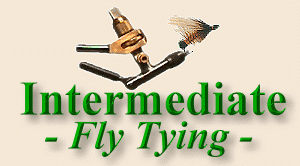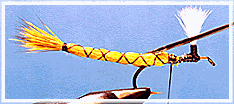
7. Apply a liberal coat of cement to the body. Be extra careful to coat
the entire thread wraps on the top, bottom and sides. This will
strengthen the tail and stiffen it enough to handle the stress of
catching fish.
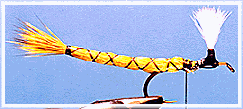
8. Apply a coat of cement to the thread base of the wing too. Allow the
cement to dry for a few minutes before you continue.
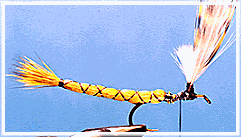
9. After the cement has dried, attach the hackle stems to the base of the
wing. You left these hackle stems 1/8 inch long instead of 1/16 inch to
allow enough stem to thoroughly attach the stem to both the wing base and
the hook. Your hackles should now be extending above the wing, curvature
facing out.
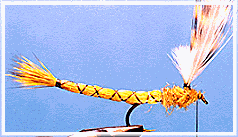
10. Dub a thorax similar in color to the body. Be sure to leave plenty
of room for the head of the fly.
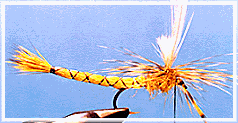
11. Wrap the first hackle down the wing base, keeping the curvature of
the hackle facing downward. This will angle the tips of the barbules
downward, causing the fly to ride slightly higher in the surface film
than it would if you wrapped the hackle up then down the wing base. Tie
off the hackle with a couple of thread wraps, trim and secure with a half
hitch.
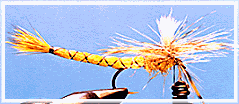
12. Wrap the second hackle down the wing base, tie off, trim and secure
it as you did with the first hackle.
13. Build a head, whip finish and cement the head. A drop of head cement
to the top of the wing base should help hold the hackle in place and
strengthen the wing.

14. Your finished fly should look like this.
Experiment a little with other colors and different hackle. Dragonflies
come in a variety of colors, so yours should too. Try tying a few
smaller mayfly patterns with these methods too.
As I've said several times, my goal is not to teach you specific fly
patterns with specific colors and materials. My goal is to teach you
methods that will be usable in many fly patterns. You can find pattern
books almost anywhere, but few of them teach the methods rather than the
patterns. I hope you're learning methods that will reach across the
pattern boundaries to many other flies as well.
An example of what I'm talking about would be parachute flies. If you
can tie a parachute Adams, you can tie a parachute Royal Wulff or maybe a
parachute Blue Dun. If you can tie a parachute extended body fly, you
surely could tie a thorax hackled, extended body fly as well. If you can
place hair wings on a Royal Wulff, what's to prevent you from placing the
same wings on an Adams?
Innovation and experimentation are the keys to new fly development.
They are the keys to localized patterns. If you learn the methods and
apply them to other types of flies, you can adapt to any type of water
and any conditions that are thrown at you. If you learn the methods, you
can pick up any pattern book and tie any fly in that book. The key is
the methods.
That's why you'll see me stress that you learn how to do specific types
of flies rather than specific patterns. That's why I stress that this is
your fly and you can tie it any way you need to. All you need to do is
learn the methods used in a type of fly and apply those methods to any
other fly that is similar in type or design.
We've come a long way since this series started. We've got a long way
to go still. I thank those of you who have joined me this far in the
series and invite you to continue with me as we together explore new
methods and new techniques in fly tying. If you think about what we've
already covered (nymphs, dries) and consider where we have yet to go (wet
flies, bass flies, streamers, hair bugs, saltwater, salmon), you'll get
an idea of how big this project is and will be.
For those who have e-mailed questions, I hope I've answered them to your
satisfaction. For those who have sent comments and compliments, I thank
you. Not only are these your flies to determine how you want to tie
them, this is your series as well as mine. I welcome your suggestions
and requests for certain techniques you wish to see covered.
See ya next week - Remember, I'm always happy to answer
your questions, feel free to
email me. ~ Al Campbell
Be sure to read Al's Product Review on Mustad Hooks in
Product Review!
Fly Tying Archives
|
